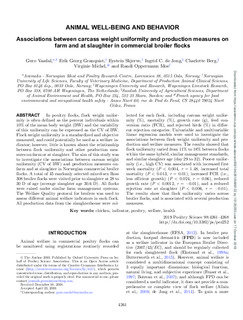| dc.description.abstract | In poultry flocks, flock weight uniformity is often defined as the percent individuals within 10% of the mean body weight (BW) and the variability of this uniformity can be expressed as the CV of BW. Flock weight uniformity is a standardized and objective measured, and could potentially be used as a welfare indicator; however, little is known about the relationship between flock uniformity and other production measures on-farm or at slaughter. The aim of this study was to investigate the associations between carcass weight uniformity (CV of BW) and production measures on-farm and at slaughter in Norwegian commercial broiler flocks. A total of 45 randomly selected mixed-sex Ross 308 broiler flocks were visited prior to slaughter at 28 to 30 D of age (average slaughter age 30.6 D). All flocks were raised under similar farm management systems. The Welfare Quality protocol for broilers was used to assess different animal welfare indicators in each flock. All production data from the slaughterhouse were collected for each flock, including carcass weight uniformity (%), mortality (%), growth rate (g), feed conversion ratio (FCR), and rejected birds (%) in different rejection categories. Univariable and multivariable linear regression models were used to investigate the associations between flock weight uniformity and production and welfare measures. The results showed that flock uniformity varied from 11% to 18% between flocks within the same hybrid, similar management standards, and similar slaughter age (day 29 to 32). Poorer uniformity (i.e., high CV) was associated with increased first week mortality (P < 0.004, r = 1.48, increased total mortality (P < 0.013, r = 0.01), increased FCR (i.e., less efficient growth) (P < 0.024, r = 0.06), reduced growth rate (P < 0.0012, r = −0.01), and a reduced rejection rate at slaughter (P < 0.006, r = −0.01). The results show that flock uniformity varies across broiler flocks, and is associated with several production measures. | nb_NO |

